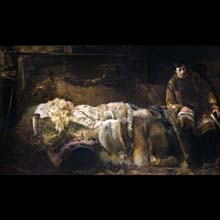
material: oil on canvas
dimensions: 212 × 370 cm
description: Malczewski drew inspiration from the poem "Anhelli" by Juliusz Słowacki for almost forty years, from the time of his studies at the School of Fine Arts in Krakow until 1918, the year when Poland regained independence. Based on the content and mood of the poem, the artist painted a series of works portraying not only the life of a young exile called Anhelli and his companion in misery, Ellenai, but also the hell of the Siberian penal servitude in a broader sense. The artist invested the scene of death of Ellenai with monumental quality. The position of the body, emphasized with horizontal lines of the elements of the background, and the figure Anhelli, frozen with pain and helplessness, convey the stillness and silence of death. A uniform brown and golden palette and diffused light, focussing on the woman’s body and hair, facilitate contemplation of the scene. Malczewski resigned from conveying the mystical nature of the exile’s death. He painted a naturalistic work imparting genre-historical character to it. The artist was probably inspired by a renowned work by Józef Simmler entitled Death of Barbara Radziwiłł (1860), which delighted the public with its elegiac mood and technical brilliance. Wacława Milewska
exposition: The Gallery of 19th Century Polish Art in Sukiennice,
The Cloth Hall, 1, Main Market Square
key: Around the academy >>>
dimensions: 212 × 370 cm
description: Malczewski drew inspiration from the poem "Anhelli" by Juliusz Słowacki for almost forty years, from the time of his studies at the School of Fine Arts in Krakow until 1918, the year when Poland regained independence. Based on the content and mood of the poem, the artist painted a series of works portraying not only the life of a young exile called Anhelli and his companion in misery, Ellenai, but also the hell of the Siberian penal servitude in a broader sense. The artist invested the scene of death of Ellenai with monumental quality. The position of the body, emphasized with horizontal lines of the elements of the background, and the figure Anhelli, frozen with pain and helplessness, convey the stillness and silence of death. A uniform brown and golden palette and diffused light, focussing on the woman’s body and hair, facilitate contemplation of the scene. Malczewski resigned from conveying the mystical nature of the exile’s death. He painted a naturalistic work imparting genre-historical character to it. The artist was probably inspired by a renowned work by Józef Simmler entitled Death of Barbara Radziwiłł (1860), which delighted the public with its elegiac mood and technical brilliance. Wacława Milewska
exposition: The Gallery of 19th Century Polish Art in Sukiennice,
The Cloth Hall, 1, Main Market Square
key: Around the academy >>>












